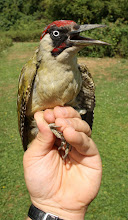Firstly, a quick note to say sorry about the incorrect formatting on my last post - I don't know what Blogger did, but it certainly wasn't written in one big block!
It's been a while since I posted some photogrpahs and accounts of my ringing activities. I have been out ringing, in between scattering my Dad's ashes, dealing with his stuff, bad weather and taking well earned rests!
Scattering my Dad's ashes went as well as could be hoped for. Everything went smoothly, it didn't rain although the clouds did look threatening! My dad would have liked the moody skies, the location, how we did it and that we were joined by a pair of Ravens, a Sparrowhawk and with near perfect timing and as I'd hoped, just after the last scattering - a Red Kite. He would have liked that too.
I also did some ringing at my dad's house. There were few birds about but I did manage to catch 20+ House Sparrows (more than I've ringed there before in total) and a new species - Chiffchaff. Elsewhere, however, the best day started thus:
Sunrise at Sandy Smith Nature Reserve, above, on 20th August 2013. The sunrise was good as I drove into the site but as I walked round the corner carrying my equipment, I had one of those moments where you just have to stop and say 'wow' and drink in the beauty of the moment.
The day continued well with 78 birds in total (retraps in brackets):
Great Spotted Woodpecker 0 (1)
Dunnock 4 (1)
Robin 3 (1)
Whitethroat 3 (0)
Blackcap 3 (0)
Chiffchaff 4 (1)
Willow Warbler 6 (0)
Coal Tit 1 (0)
Blue Tit 5 (13)
Great Tit 3 (20)
Chaffinch 3 (1)
Goldfinch 4 (0)
and best of all...
Above: Spotted Flycather (2nd ringing record for the site, previous being in 2011). A juvenile, presumably on migration or a local roaming around.
A session previous to this, on 10th August, again at Sandy Smith NR, exactly 100 birds were caught of 14 species:
Wren 4 (1)
Dunnock 3 (2)
Robin 1 (1)
Reed Warbler 1 (0) - 2nd this year and only the third ringed for the site
Whitethroat 8 (1)
Blackcap 3 (1)
Chiffchaff 9 (0)
Willow Warbler 2 (0)
Long Tailed Tit 3 (1)
Marsh Tit 1 (0) - only 3rd ringed for the site
Blue Tit 8 (8)
Great Tit 7 (29)
Treecreeper 1 (0)
Chaffinch 4 (1) - there are a LOT of juv chaffinches this year!
Above: Marsh Tit
It's been an interesting year so far at SSNR. New for year totals of Great Spotted Woodpecker, Chiffchaff, Willow Warbler, Goldcrest, Long Tailed Tit, Coal Tit, Great Tit, Treecreeper and Chaffinch are all higher than in previous years (operating since 2010) whilst Redwing and Jay have been added to the ringing list this year.
Last year, I set myself a goal of reaching 1000 captures at SSNR for the year (and just made it). This year, I have been keeping tabs on my progress and (adding yesterdays total of 41) I have reached 870 captures (of 30 species), putting me ahead of schedule in comparison to the previous two years.
Breaking this down into effort, I reckon I've had 1 or 2 more nets up and they've been up for longer rather than making more visits. I've also got wiser about the catching some species, but then some species are more abundant this year and some are less so. So, a bit of swings and roundabouts then!
Before reaching 1000 for this year though, I think the next milestone will be the 2000th new bird ringed as 39 more new birds are needed for this.
A quick mention for Priory Country Park - with the help of other members of the Ivel Ringing Group & visitors, we completed all 12 visits of the Constant Effort Survey. I haven't studied the results in any depth but I can tell you that overall, this is one of the worst recorded years since it started in 1992. I will put something up soon about this on the
Ivel Ringing Group Blog.
Lastly, I can now share a photograph with you from a ringing session on 7th July, 2013.
Above: A Juvenile Jackdaw
This is the second Jackdaw (both juveniles) ringed at SSNR following one last year (when I didn't have my camera with me). This was caught on the day my dad passed away. A day which, apart from the obvious, was a perfectly nice and enjoyable day.




